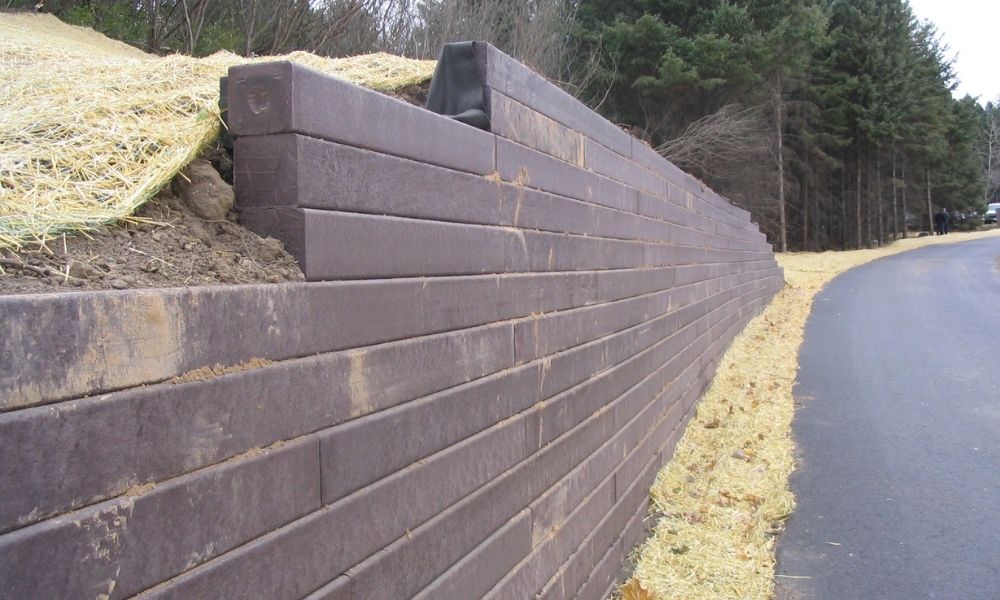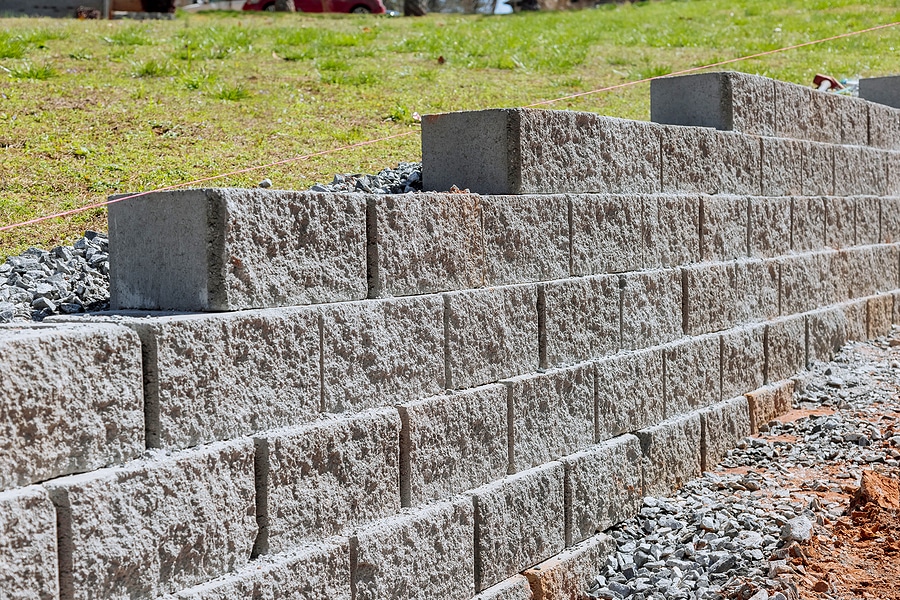Maintenance strategies to keep OKC Precision Retaining Walls standing strong for decades
Maintenance strategies to keep OKC Precision Retaining Walls standing strong for decades
Blog Article
Secret Considerations for Building Reliable Retaining Walls in Your Lawn
When you're thinking about developing a maintaining wall in your yard, it's vital to assume regarding several vital variables. The wall surface's function, the materials you'll make use of, and the certain soil problems can all impact its effectiveness and long life. You'll likewise need to browse local building ordinance and plan for proper water drainage. However how do you ensure your design not just meets these needs however also improves your landscape? Allow's explore the vital steps together.
Understanding the Function of Your Retaining Wall
When you think of developing a preserving wall surface, consider its major purpose: supporting soil and protecting against disintegration. Retaining walls give necessary support for sloped landscapes, helping to keep soil stability. You'll find they're essential in areas where water overflow might or else wash away dirt, leading to expensive repair services and landscape damages.
By keeping back planet, these walls create level surface areas for yards, patios, or pathways. This not only enhances your lawn's aesthetics but additionally advertises better drainage, decreasing water pooling in unwanted areas. If you're handling high inclines, a sound retaining wall surface can protect against landslides, ensuring safety for you and your residential property.
Ultimately, comprehending the purpose of your retaining wall will guide your design choices and aid you create a practical, resilient structure that meets your demands. Take a minute to review your landscape; it'll pay off in the long run.
Selecting the Right Materials
When selecting materials for your retaining wall, you'll wish to take into account sturdiness, aesthetic appeals, and price. Each aspect plays a necessary function in ensuring your wall surface stands the examination of time while looking terrific and fitting your budget. Allow's discover exactly how to make the very best selections for your job.
Material Durability Variables
Selecting the right products is important for the longevity and performance of your retaining wall, because their resilience straight impacts the wall surface's capability to withstand ecological tensions. Start by considering your neighborhood climate; products like concrete and stone withstand moisture and temperature level fluctuations well. If you stay in an area susceptible to hefty rainfalls, select materials with great drainage residential or commercial properties, like crushed rock or porous blocks, to protect against water buildup.
In addition, consider the dirt conditions on your home. Some products carry out better in particular soil types, so it is necessary to match them appropriately. Be conscious of possible wear from pests or erosion. Choosing sturdy materials guarantees your retaining wall surface stands solid, safeguarding your backyard for several years to come.
Aesthetic Design Choices
Long lasting products not just assure your retaining wall surface's architectural honesty but also play a key function in its visual charm. When selecting the best materials, consider exactly how they match your landscape. Natural stone provides an ageless, rustic look, while concrete blocks can give a smooth, contemporary finish. You may additionally consider utilizing hardwood for a cozy, organic feel. Color and appearance issue, as well; pick tones that balance with your home and garden. Don't forget the wall surface's shape-- rounded walls can create a softer appearance, while straight lines can really feel a lot more structured. By very carefully choosing materials that line up with your visual vision, you'll boost your outdoor room while ensuring your wall surface stands strong against the aspects.
Cost-Effectiveness Analysis
Picking the right materials for your retaining wall surface isn't simply about aesthetic appeals; it's additionally important for your budget plan. When picking products, consider both upfront expenses and long-term toughness.
Do not neglect to factor in maintenance costs. Some materials, like natural stone, can include appeal and call for much less maintenance, while others could require normal therapies
Inevitably, consider the pros and cons of each option against your budget and the wall's desired purpose. Investing wisely in materials currently can protect against expensive problems down the roadway. Select materials that balance cost and performance efficiently.
Examining Soil Conditions and Drainage
As you begin your project, evaluating dirt problems and drain is essential for the success of your retaining wall. Start by examining the sort of dirt in your lawn. Sandy soil drains pipes well yet does not have stability, while clay soil can retain dampness, causing press on your wall. Examine the soil's moisture content by excavating a tiny hole and observing just how quickly it dries out.
Following, evaluate the incline of your lawn. If water normally flows towards your wall, you'll require to carry out a drainage remedy to stop erosion and pressure buildup. Take into consideration installing perforated pipelines or gravel backfill behind the wall surface to help with water drainage.
Last but not least, observe any type of neighboring trees or greenery; their origins can affect dirt stability. By recognizing your dirt conditions and implementing appropriate water drainage, you'll create a strong foundation for your retaining wall surface that stands the examination of time.
Conforming With Local Building Ordinance
Before you begin constructing your retaining wall surface, you require to research local laws to guarantee compliance. It's vital to comprehend what allows you must acquire, as this can conserve you from costly fines or having to remodel your job. Taking these steps seriously will assist you construct a safe and effective structure.
Research Study Local Laws
Recognizing local guidelines is crucial when intending your retaining wall surface task, specifically given that constructing codes can differ greatly by location. Start by checking with your local structure division or community to learn more about particular requirements. Look for guidelines on wall surface elevation, materials, drainage systems, and architectural honesty. Lots of areas have restrictions on the sorts of products you see this site can make use of and exactly how high you can develop. You'll also wish to consider the zoning legislations that might affect your task. Neglecting these policies can result in pricey penalties or the need to redo your job. By doing your research study upfront, you can guarantee your retaining wall surface meets all essential codes and blends effortlessly into your yard.
Get Required Licenses
As soon as you've looked into local guidelines, the next step is to get the necessary licenses for your retaining wall surface project. This procedure warranties your wall abides by building regulations and security criteria. Get to out to your local building authority to figure out what allows you require. They might call for details strategies or design assessments, especially for bigger walls. Be prepared to submit comprehensive illustrations, consisting of dimensions and products. Do not fail to remember to examine if your project impacts drain or bordering residential properties, as these variables could require added authorizations. Protecting the best approvals can save you from costly penalties or having to dismantle your wall later. Bear in mind, following the policies now will certainly bring about a smoother building experience.

Planning the Design and Aesthetics
As you commence preparing the layout and visual appeals of your retaining wall surface, take into consideration just how it will integrate with the bordering landscape. Think of the materials you'll use-- rock, brick, or concrete-- important site and how they'll complement your home's design and the natural elements in your yard. Choose colors and structures that mix perfectly with existing features like patio areas, pathways, or gardens.
Following, picture the wall's shape and elevation. Curved walls can soften an inflexible landscape, while straight lines may share a more contemporary appearance. Do not fail to remember to integrate plants and plant around the wall surface for an all-natural touch; this can boost its appeal and incorporate it into the environment.
Lastly, bear in mind performance. Your layout needs to not just be aesthetically pleasing however additionally serve its purpose efficiently. By attentively planning these elements, you'll create a retaining wall surface that enhances your yard's appeal while fulfilling its architectural duty.
Calculating Height and Thickness Requirements
To build a durable retaining wall surface, you require to accurately compute its elevation and density demands based on the soil problems and the height of the incline it will certainly support. Start by reviewing the incline's angle and the sort of soil, as various soils put in differing quantities of pressure.
For walls over four feet high, think about a thickness of a minimum of 12 inches. If the wall is taller, increase the density proportionally to maintain stability.
Following, compute the elevation of the wall surface by determining the vertical range it requires to keep. For every foot of elevation, you need to typically prepare for a density of one-third of the wall's height.
Always keep in mind to make up extra variables like drain and backfill, which can affect your wall's design. Proper computations currently ensure your retaining wall stands strong and lasts for years to come.
Upkeep and Long Life Factors To Consider
While preserving your retaining wall might look like a low priority, ignoring it can result in considerable concerns in time. Routine evaluations are crucial; check for fractures, protrudes, or any type of indications of water damage. Addressing these troubles early can conserve you from expensive fixings later on.
Keep an eye on water drainage systems, as well. Clogged drains can cause water to accumulate, exerting stress on your wall and compromising its stability. Clear debris and guarantee appropriate circulation to maintain longevity.
You may also want to show on securing your wall to shield it from wetness and weathering. Relying on the product, this may require reapplication every few years.
Finally, landscaping around your wall surface can sustain its integrity. Avoid growing huge trees close by, as their origins can undermine the foundation. With positive maintenance, your retaining wall surface can serve you well for several years ahead.

Often Asked Concerns
Can I Develop a Retaining Wall by Myself, or Should I Hire a Professional?
You can definitely build a preserving wall on your own if you have the right devices and expertise. Nevertheless, working with a specialist warranties it's done correctly, specifically for bigger or even more complex structures. Consider your ability level prior to determining.
What Are one of the most Common Errors Made When Structure Retaining Walls?
When developing retaining walls, you might forget appropriate drain, avoid making use of the best materials, or overlook support. These common blunders can lead to useful reference structural failing, so take your time and plan meticulously to stay clear of problems.
Exactly how Do I Know if My Retaining Wall Requirements Reinforcement?
You'll understand your retaining wall requires support if you observe fractures, leaning, or protruding. Look for water merging behind it or soil erosion near the base. Address these indications without delay to avoid additional damages.
What Plants Are Ideal for Landscaping Around a Retaining Wall?
When landscape design around a retaining wall surface, consider using low-maintenance plants like succulents, ornamental yards, or sneaking ground covers - OKC Precision Retaining Walls. They'll grow in those conditions and include elegance while protecting against dirt erosion around your wall
Exactly How Can I Prevent Erosion Around My Retaining Wall?
To avoid disintegration around your retaining wall surface, you can grow ground cover, usage mulch, and mount drain systems. Routinely look for water accumulation and change landscaping to redirect overflow far from the wall.
Report this page